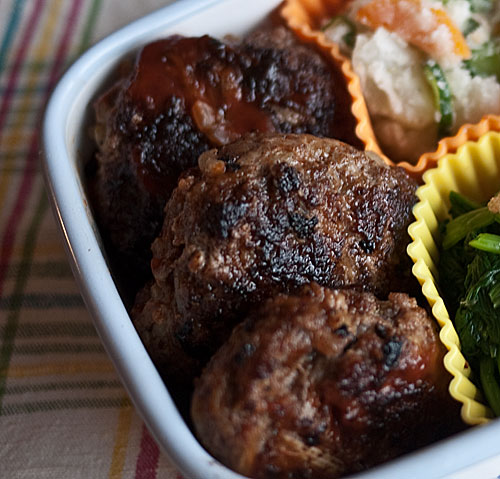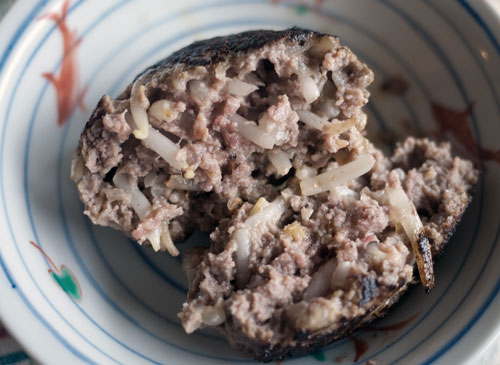Lower-calorie, lower-cost, beef and bean sprout burgers
Little burgers made with meat with or without tofu, canned tuna, or even beans are a perennial bento standby - they remain rather juicy even when cold, and are quite economical too. Plus, they are great make-ahead items, to stash for a few days in the refrigerator or for about a month in the freezer.

This version is a variation on the basic Japanese style hamburger. Japanese style hamburgers are often made with a 50/50 mixture of ground pork and beef, but you can use 100% beef as I've done here. Some chopped up bean sprouts are added for extra texture, as well as to lower the overall fat/calorie count. You can make a big 'half-pound' size burger with this mixture but it will have less calories than an all-meat burger. Adding bean sprouts also makes the burgers more economical. In Japan, meat is expensive while bean sprouts are cheap, so bean sprouts help to keep the household budget trim as well as your waistline!
Here's one split in the middle, so you can see the bean sprouts. Granted, they do look a bit weird, but trust me, these burgers taste great hot or cold.

I would suggest making a batch of the hamburger mixture, having big ones for dinner and reserving a few little ones for bento the next day or later. You can freeze these burgers either before or after cooking. I prefer to cook them and freeze them, so they can just be reheated/defrosted and are ready to go.
Recipe: Japanese style beef burgers with bean sprouts (moyashi baagaa)
Makes about 24-30 small-to-mini sized burgers. Or you can divide the mixture into two and use half to form 2 big burgers for dinner, and the rest into mini burgers.
- 700g / about 1 1/2 lbs. ground beef or a 50/50 mix of ground pork and beef
- 1 medium onion, finely chopped
- 1/2 cup (120ml) panko or dried breadcrumbs
- 1-2 Tbsp. milk or water
- 1 egg
- 1 tsp. salt
- freshly ground black pepper
- 2 large handfuls of bean sprouts, with the 'bean' part removed, roughly chopped
- oil for cooking
- ketchup and/or Worcestershire sauce and/or 'Bulldog' sauce (optional)
Sauté the onion in a little oil until transparent.
Moisten the breadcrumbs with the milk or water (you can also use fresh breadcrumbs, in which case you don't need to ooisten them. Use a bit more than the 1/2 cup called for in that case.)
In a bowl mix the meat, onion, breadcrumbs, egg, salt and pepper together with your hands until a bit sticky. Add the bean sprouts, and mix in well.
Form into patties. Follow the directions for basic hambaagu for cooking and optionally saucing the burgers.
If you are going to freeze the cooked burgers, cook them without sauce, and allow them to cool down. Put on a single layer on a plate or tray and freeze, then pack into freezer-safe bags or containers. They'll keep for a month. To use, defrost in the microwave (or overnight in the fridge), then heat up over low-medium heat in a non-dry stick frying pan; when heated through, you can add the sauce as per the hambaagu instructions if you like. For bento-use burgers it's best to cook the sauce down until sticky, so it doesn't leak out of your box during transit. You can of course optionally pack a separate bottle of sauce along.
I find it's best to heat the burgers through in a pan rather than heating them up in a microwave for the best texture. If you're in a hurry though, just let rock-hard frozen burgers partially defrost (in the fridge or microwave), and pack them cold in your box; they will have defrosted by lunchtime - and yes, unless you leave your box in a hot room and you follow basic bento safety tips, they should be fine.
American style all-meat burgers for bento?
Whenever I put up a burger - or in Japanese-English, "baagu" recipe, someone invariably pipes up that they aren't 'burgers'. This is quite true: they aren't American style beef burgers. If you watched the Top Chef All Stars season that aired a few months ago, you may have noticed that Fabio, who is from Italy, utterly screwed up what the (American) judges' idea of what a 'burger' should be, and thus got eliminated. Instead of making pure beef batties with a salty crust, which is what they expected, he made sort of meatballs, or what used to be called hamburger steak (this only seems to live on in American food culture as the frozen dinner standby, the Salisbury steak). This style of 'burger' is what prevails in Japan, where often the American style all-meat hamburger is called 'hambaagaa' to differentiate itself from the 'hambaagu'. American style all-meat burgers do not do well in bentos, as anyone who's eaten a cold Big Mac can attest to. The meat gets sort of grey and sad and dry with congealed grease, the juices having run out to the bun, making the bread soggy and really sad. With the Japanese 'hambaagu' style of burger, even cold ones are perky and tasty, especially with a little sauce on them.
If you enjoyed this article, please consider supporting this site by becoming my patron via Patreon.
